WCLT Invests in Gilmore Pond Dam Repair
The Westborough Community Land Trust recently made a major investment to make repairs to the Gilmore Pond Dam.
[MORE]
|
Charm Bracelet 10th Anniversary Celebration
Save the date for a "bring-your-own picnic" celebration of the 10th anniversary of the Charm Bracelet!
[MORE]
|
WCLT on Westborough TV
Westborough residents with cable TV have had the opportunity to view Westborough TV programs on several WCLT walks.
[MORE]
|
From the Outreach Committee:
Speaking of Conservation . . .
Have you ever wondered about the best ways to talk about conservation to friends, neighbors, or people you don't know?
[MORE]
|
See Live New England Animals
WCLT offers an exceptional opportunity to see wild animals up close! [MORE]
|
Let's Clean Up Westborough for Earth Day
Every year, WCLT leads a town-wide clean-up in honor of Earth Day.
[MORE]
|
Earth Day Essay Contest and WCLT 2010 Scholarship
It's time for Westborough High School (WHS) seniors to enter WCLT's Earth Day Essay Contest!
[MORE]
|
Climate change in Massachusetts
What's the outlook in Massachusetts for climate change?
[MORE]
|

Photo courtesy of Brian Waterman
The Westborough Community Land Trust (WCLT) recently made a significant expenditure representing a major investment in its
Gilmore Pond property when the frozen ground of winter allowed heavy equipment to reach Gilmore Pond to make repairs to the dam
there.
The cost of the repairs is approximately $15,500, including costs for permits. The total is about equal to WCLT's typical
total annual expenditure.
"These repairs will ensure that the pond remains intact for Westborough residents to enjoy viewing for decades to come," said
WCLT president Garry Kessler. "Everyone agrees that Gilmore Pond is a gem."
Located off Gilmore Farm Road, the 2.6-acre pond was originally created as a fire pond in the 1930s, when the surrounding area
was mostly orchards and farmland. Over time, the dam had fallen into disrepair.
WCLT acquired the 13-acre Gilmore Pond property in 2003. With important financial and volunteer contributions from the
Westborough Civic Club, WCLT has been leading an ongoing multi-year restoration project to improve trails, remove invasive shrubs,
and open scenic views of the pond. Many additional volunteers from the community have worked on the project, including groups from
Boy Scouts, Girl Scouts, Westborough High School, and Congregation B'nai Shalom.
When the restoration is complete, Gilmore Pond will be the centerpiece of a park-like woodland where Westborough residents can
walk the trails year-round. In the meantime, the area remains open to foot traffic.
Recently, WCLT director Sharon Williams recorded more than 51 species of birds at Gilmore Pond and vicinity over a one-year
period. The pond and its surroundings attract both resident and migrating birds.
An early claim to fame for the pond is that Westborough hockey got its start on the winter ice there, many decades ago, with
Dick Gilmore as coach. The informal games led to the formation of the Westborough High School hockey team.
Gilmore Pond is part of the headwaters of Jackstraw Brook, one of the major streams in Westborough. The brook is also fed by
branches in the surrounding area and flows to Cedar Swamp, where the Sudbury River originates. The brook forms a wildlife corridor
leading to Cedar Swamp.
A free trail map of WCLT's 67-acre Upper Jackstraw Brook Reservation, which includes Gilmore Pond, can be viewed or downloaded
and printed from the WCLT web site.
Back to top
|
|
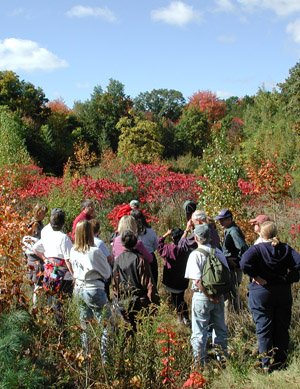
Ten years ago, more than 50 people attended the inaugural walk on the first section of the Charm Bracelet in October. Their
destination was WCLT’s Hidden Meadow in Bowman West.
Save the date! This fall, a "bring-your-own" picnic celebration of the 10th anniversary of the Charm Bracelet will take place on
Sunday afternoon, September 26, on the grounds of Mill Pond School, with walks on nearby trails.
Today, Westborough's Charm Bracelet trail system is a well established fact of life in town, connecting many open space areas and
offering pleasant walks through the woods to people in several neighborhoods. Yet, 10 years ago, it was a just an idea – a vision – in
the mind of Don Burn.
The Charm Bracelet project made its public debut a decade ago, when Don presented it to the Board of Selectmen on March 21,
2000. He had already won support for the concept of a trail network from both the town's Open Space Preservation Committee
(OSPC), of which he was a member, and the Westborough Community Land Trust (WCLT), in fall 1999. The Charm Bracelet name,
suggested by WCLT member Harry Newell, had already caught on.
By September 2000, multiple trail projects were underway to build trails in the Bowman Conservation Area and in Bowman West
(the open space area across the street from the conservation area parking lot).
Fall 2000 saw the official launching of the Charm Bracelet, when more than 50 people attended the first walk on the first
section of the Bracelet on October 7. They followed the Charm Bracelet from Minuteman Park (on Upton Road) through the Bowman
Conservation Area and its parking lot (off Bowman Street), then across the street and through Bowman West to the meadow there,
and back again, for a 3-mile round trip.
To see the route taken, or to walk it yourself, look at the trail maps for the
Bowman Conservation Area and
Bowman West,
which can be accessed from the home page of the WCLT web site.
Ten years later, Westborough now has 21 miles of Charm Bracelet trail and 24 miles of side trails, thanks to the Charm Bracelet's
tireless champion Don Burn and the labors of countless volunteers from the community, including many from WCLT, the OSPC, Boy Scouts
and Eagle Scout candidates, and other groups.
Much has changed in the past 10 years. WCLT restored its meadow in Bowman West and named it Hidden Meadow in 2004-2005.
The Mill Pond School was constructed on the Andrews-Nourse property, and in 2003, the remaining 100 acres became the town's Headwaters
Conservation Area. Trails now crisscross this area, leading to popular destinations such as Osprey Point on Mill Pond.
For a trail map of the Headwaters Conservation Area, check the home page
of the WCLT web site or click here.
Today, Westborough is 85 percent built out, making its open space more precious and more desirable than ever.
The Charm Bracelet links many of these open space "charms," which include town-owned properties, state-owned properties,
WCLT-owned properties, and properties belonging to other land trusts such as Sudbury Valley Trustees (SVT) and the New England
Forestry Foundation (NEFF). The Bracelet also connects neighborhoods and schools, making it possible for Westborough residents
to travel on foot through the local countryside.
Work on the Charm Bracelet continues toward the goal of an unbroken 28-mile loop around Westborough, but progress is likely
to be slow. Another 7 miles of main trail are needed, awaiting easements and acquisitions that would allow existing stretches of
trail to be connected. In addition, about 20 more miles of side trails are planned.
See Trail Tales to read about one of Don Burn's favorite walks along the Charm Bracelet.
Back to top
|
|
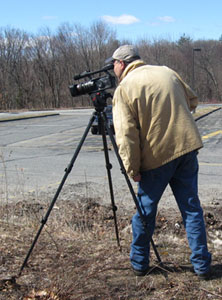
If you've attended a WCLT walk lately, you may have noticed a video camera focused on the event. Or if you get local cable TV,
you may have seen a program showing a recent WCLT walk.
The friendly face behind the video camera is Tim Novak of Westborough TV (WTV), a Westborough resident, nature-lover, and
experienced outdoorsman. His programs make it possible for people in town to enjoy WCLT walks and events even when they aren't
able to attend them. Residents who go on WCLT walks can also enjoy what they saw again, and review what they learned, by tuning
in to the WTV programs.
Most recently, Tim and his camera showed up at WCLT's February Mammal Tracking walk, held at MassWildlife's Westboro
Management Area with Martha Gach of Mass Audubon's Broad Meadow Brook Sanctuary. Look for the upcoming program about this event
on the public TV channel (11 Charter / 24 Verizon).
In the past year, Westborough residents with cable TV have had the opportunity to view Westborough TV programs on several WCLT
walks. (See listing below for WTV Programs on WCLT Events & More.)
These shows are part of WTV's effort to increase awareness of the nonprofit organizations in town and the work they do, such as
WCLT and its educational walks and talks about Westborough's natural environment.
"We want to bring Westborough to Westborough," explains WTV executive director Donna Kelly.
She notes that the mission of Westborough TV is to serve the community of Westborough through creation of broadcast media
programming that is by, about, and for the Westborough community.
Copies of WTV-produced programs on WCLT events are available from WTV.
"We will make copies at $10 per DVD, or you may bring your own DVDs (name brand suggested) and we will teach you how to make
your own copy at no charge," Donna says.
"We are located on the lower level at 30 Lyman Street, Suite 80 (the plaza anchored by Profilo and Il Forno). Our hours are
Monday and Tuesday 9 am - 6 pm, Wednesday and Thursday 9 am - 7 pm, and Friday 9 am - 5 pm."
For members of the community who are interested in creating programs, WTV also provides one-on-one training in everything
from operating a camera to lighting a set to directing a show.
Check the broadcast schedules on the WTV website.
WTV Programs on WCLT Events & More
Watch for these Westborough TV programs on 11 Charter / 24 Verizon. Visit the Westborough TV offices at 30 Lyman Street,
Suite 80, to make your own DVD copy of a program at no cost, or to purchase a copy for $10.
Westborough TV programs featuring WCLT events:
- Mammal Tracking (with Martha Gach of Mass Audubon at the Fish and Wildlife Westboro Management Area) - NEW
- WCLT's RockIt! (about Westborough's geology with Andy Koenigsberg at the Lee Property and Headwaters Conservation Area)
- Fall Foraging, parts 1 and 2 (with Arthur Haines of the New England Wild Flower Society at St. Luke's field)
- Spring Lady's-Slipper Walk (with Annie Reid at Bowman Conservation Area)
Other Westborough TV programs about Westborough's natural environment:
- Bluebirds (with Marty Newark)
- Cedar Swamp History and Archeology with Dr. Chris Hoffman (by Al Sanborn)
Back to top
|
|
By Elaine Birkholz
Have you ever wondered about the best ways to talk about conservation to friends, neighbors, or people you don't know? Or
found yourself searching for the best approach or the best words to use? If so, you're not alone.
The Nature Conservancy recently shared with members of the Massachusetts Land Trust Coalition (which includes WCLT) the results
of a fascinating survey that included recommendations for making an effective case for conservation. We can all learn a lot from
this survey about how to encourage others to support our efforts to preserve open space in our community.
The recommendations are based on extensive qualitative research and a national survey of American voter focus groups, conducted
last September by a bi-partisan research team including both Democratic and Republican polling firms. Results of the survey showed
that the majority of voters respond positively to language that includes the following:
- The "three W's" of water, wildlife, and working farms – especially when it is clear how protecting these resources directly
benefits people themselves.
- A "future generations" message. The concept of protecting land, water, and wildlife for our children and grandchildren came up
often in focus groups, without prompting from interviewers.
- The recreational value of land – specifically, ways in which people can enjoy hiking, biking, boating, fishing, viewing wildlife,
and enjoying the peace and quiet of nature on open lands.
- An explicit nod to continued or increased access to open land for recreation. According to the survey, the idea of "protecting"
or "conserving" without public access does not interest people much.
- A sense of "shared responsibility" to care for the natural world. Voters these days want to be – and want others to be –
responsible for both their own personal finances and how they treat the natural world.
- Phrases that imply ownership and inclusion, such as "our" and "we."
- Phrases that connect conservation to public health. People want clean air and water, and instinctively view caring for the
land as benefiting both.
Great food for thought for all of us, whether we serve WCLT in an official capacity or not!
Back to top
|
|
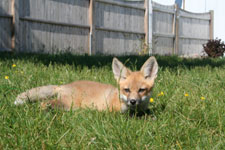
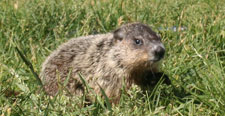
Top: Isaac the red fox; Bottom: Lilly the woodchuck
Most of us rarely get close enough for a good look at the wildlife that shares our environment here in Westborough, but once
again the Westborough Community Land Trust (WCLT) offers an exceptional opportunity to see wild animals up close by sponsoring a
live animal presentation as part of its Earth Day activities in April.
This year's presentation, by Animal Adventures, is designed for families and features live animals of New England. See them on
Saturday, April 10, 9:30-10:30 am, at Knights of Columbus Hall, 17 Willow Street.
The featured New England animals include a red fox, snapping turtle, woodchuck, skunk, ferret, milk snake, and tree frog.
These are animals that we might glimpse in Westborough, or whose tracks or other signs we might spot. Or we might read about them
in WCLT's "Nature Notes" column in the Westborough News.
WCLT is pleased to bring this program to Westborough with support from a grant from the Westborough Cultural Council. This is
the third year that WCLT has brought a live animal presentation to Westborough.
For more information about the program, click here.
Back to top
|
|
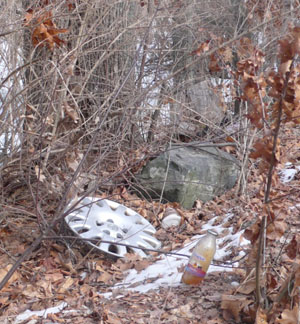
Many places in town, like this one behind Friendly’s, need to be picked up in the spring.
Every year, as the snow melts, litter and junk seem to emerge from nowhere along roadsides, trails, and in parking lots.
It's hard not to notice that Westborough seems to need an annual spring cleaning, so it has become a tradition that every year
WCLT leads a town-wide clean-up in honor of Earth Day.
How can you help? One way is to report what you see. Send an email to
WCLT Earth Day clean-up coordinator Bruce Tretter to suggest sites around town where litter needs to be picked up.
A second way is to take part in the clean-up. For many volunteers, the clean-up is a rewarding family activity. On Saturday,
April 24, clean-up groups will form at two times and be assigned sites to pick up: 6:30 am (for early birds) at the West Meadow
Plaza traffic island, and 9 am (for families) at the Lake Chauncy parking lot. Wear gloves and sturdy shoes. Trash bags will be
provided.
A third way is to organize your friends, neighbors, or co-workers to pick up litter in a particular area, or to lead a scout, church, or school group in such an effort. Groups are welcome to schedule their clean-up activities at times that are convenient for them.
A fourth way is to suggest contacts at local and area businesses that might be approached to help with the clean-up. After all,
attractive surroundings are good for business and good for employee morale. Again, send your suggestion by email to
Bruce Tretter.
The town-wide Earth Day clean-up is a WCLT tradition that started when the land trust was founded in 1997. It's a way for
everyone in town – young and old, residents and businesses, students and teachers – to work together as stewards of our community.
Back to top
|
|
With spring come thoughts of graduation and beyond, so it's time for Westborough High School (WHS) seniors who would like a
chance at the $500 WCLT 2010 Scholarship to enter WCLT's Earth Day Essay Contest. The scholarship will be awarded to the contest
winner at graduation in June.
To enter the contest, seniors should write an Earth Day essay of 500-750 words on one of the following three topics and
submit it to the WHS Guidance Office no later than Wednesday, April 28, 2010:
- An environmental issue in Westborough
Describe an environmental issue that affects a natural resource in Westborough. Propose a solution that would address this issue
and/or describe activities in which you have been involved that have worked towards solving this particular problem.
- Sustainable living in Westborough and beyond
Discuss ways that you and others of your generation could live more sustainably on Earth. If applicable, include a description of
changes you have made in your own life that have enabled you or your family to live more sustainably.
- Protection of Westborough's natural heritage and special places
Describe a place in Westborough that you think is especially important to protect, and explain why. Discuss what you have done, or
propose ways that you could help to protect Westborough's natural heritage.
The contest and scholarship forms are currently available in the WHS Guidance Office.
WCLT members can help by encouraging seniors they know to enter the contest.
Back to top
|
|
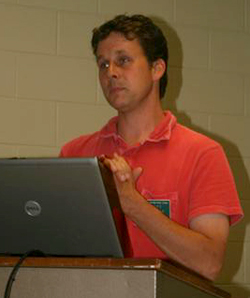
2009 annual meeting guest speaker Scott LaFleur
Photo by Andy Koenigsberg
What's the outlook in Massachusetts for climate change?
Guest speaker Scott LaFleur of the New England Wild Flower Society (NEWFS) addressed this question at WCLT's annual meeting
last June.
In New England, climate change – and warming in particular – means shorter winters, longer growing seasons, longer droughts, and wetter rainy
seasons.
The climate in Massachusetts, as depicted in USDA hardiness zone maps based on winter lows, is predicted to become more like
the climate in places that are now south of us. For example, predictions are that:
- In 2010-2039, our climate will become more like that of Connecticut and New Jersey today;
- In 2070-2099, our climate will become similar to today's climate in Atlanta, GA.
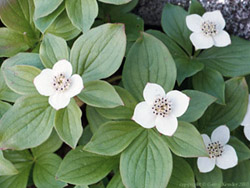
Bunchberry, a wildflower in Westborough
What are some signs of a warming climate that we can see today?
- Flowers now bloom earlier at NEWFS Garden in the Woods in Framingham.
- Bunchberry (Cornus canadensis), a native wildflower that typically doesn't do well in summer heat, no longer sets
seed at Garden in the Woods. (It can be found in Westborough.)
- Maple sugaring in Massachusetts is becoming more difficult because moderate temperatures mean that sugar maples don't always
have the combination of cold spring nights and warm spring days that produces the sap flow that's needed.
- Woolly adelgid (Adelges tsugae), an invasive aphid-like insect that attacks native hemlock trees, isn't being killed by
low winter temperatures in our area, so we are losing the hemlocks from our forests.
- Invasive plants, which tend to spread from south to north, are entering Massachusetts more readily, as we can see with the recent
arrival of invasive mile-a-minute vine.
What does climate change mean for birds? In the future, Scott says:
- Bird migration may be less well synchronized with plant flowering times, so birds may no longer find the nectar and associated
insects that they are used to finding along migration routes.
- The same applies to certain insects, such as monarch butterflies, which migrate from the eastern US to Mexico in the fall. They
need certain plants at certain times and places, but may no longer find them there.
- The northward spread of invasive plants will provide lots of "junk food" for birds. For example, the lower-quality berries from
invasive shrubs, such as burning bush, fill up birds but don't sustain and nourish them as well as many native berries do.
Climate change brings difficult decisions for people to make as they try to plan for a future with a warmer climate. For example:
- Places such as the city of Worcester, which needs to replant trees after the massive tree removal done to stop the Asian longhorn
beetle invasion, must decide which trees to replant – the same ones that grew there in the past, or different trees from more southern
locales that are likely to do well in a future warmer climate, or both?
- Controversial measures such as assisted migration, in which humans move plants or other species from a southern range to a more
northern one, can be considered or tried out. For example, in recent years the New England Wild Flower Society restored an endangered
plant, Robbins' cinquefoil (Potentilla robbinsiana), to the alpine environment high on Mt. Washington in New Hampshire. With a warming
climate, should NEWFS move this rare plant farther north to Mt. Katadin in Maine as well?
Plants and animals typically adapt gradually to changes in their environment, over many generations, but today's climate change
may be occurring too quickly for many of them to adapt in this way.
To explore further, Scott recommends visiting: www.budburst.org
Back to top
|
|
|